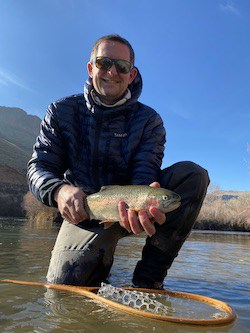Pareto’s Law and Fly Fishing
My Debatable Tenets
Feb. 23rd, 2022
Pareto’s law and fly fishing are inextricably linked. They’re inseparable. If you pay attention, you’ll see Pareto’s law at work every time you’re on the river.
I’m a numbers guy, and I find this stuff interesting. With that said, there’s a decent chance you’ll disagree with my findings after reading this article. But, I’m convinced this is truth supported by anecdotal data.
Pareto’s law is also known as Pareto’s principle, the law of the vital few, and the principle of factor sparsity.
But, it’s better known as the “80/20 rule.” You’re likely familiar with the 80/20 rule. Regardless, I’ll explain it shortly.
Here’s how I believe it applies to fly fishing.
What is Pareto’s law?
I’ll keep this short.
Vilfredo Pareto was an Italian economist who is best known for discovering what came to be known as the 80/20 rule, or Pareto’s law. He presented his momentous findings in 1906 after researching income distributions.
Pareto’s law states that around 80% of consequences are derived from 20% of causes.
So, for example, 80% of home runs are hit by 20% of baseball players.
Or, 80% of a company’s sales come from 20% of its products.
I think you probably get the picture. Now, let’s talk about how this principle is seen on the river.
Fly Fishing and the 80/20 Rule
I spend a lot of time on the water, and I’ve seen and met plenty of fly anglers. I know beginners, intermediates, and experts alike.
Lately I’ve been thinking about the distribution of fish caught. Because, naturally, the more experience you have, the more likely you’re catching fish.
After digesting what I’ve observed over the years, I’m now convinced that 20% of fly anglers catch 80% of the fish. Frankly, it might even be 15% of anglers catching 85% of the fish.
Would you agree?
What helped cement this notion is thinking how often I watch anglers catch nothing.
I remember speaking with a nice guy who was a fellow member at a fly fishing club. He’d mentioned that he’d only caught one fish since he started fly fishing, and that it was foul-hooked, but that the fish was still going for his fly.
Another guy said he “caught” three trout, all foul-hooked, and that it was his best day yet on the water. I found this puzzling.
Side note: if you foul-hook a fish, you didn’t catch it. It doesn’t count. It may as well have never happened.
Anyway, here’s something else I’ve come to believe.
I’m confident that 20% of flies catch 80% of the fish. It’s probably even more skewed than that honestly.
Think about all the flies you have, then consider how many have actually been in a fish’s jaw. Then consider the distribution of fish amongst those flies.
It’d be really interesting to learn what percentage of nymph sales the pheasant tail is responsible for garnering. It’s got to be hugely disproportionate. I’m guessing here, but I wouldn’t be surprised if 80% of fly revenues came from 20% of the available flies.
I can’t prove any of these “tenets,” and they’re certainly not scientific in the least. But they’re food for thought.
They’re not far fetched, either.
I read in a golfing magazine years ago that 90% of golfers can’t break 90. That’s insane, considering the millions of golfers out there. It’s hugely skewed.

Are you in the 80 or the 20?
If you’re in the 80% of fly anglers who aren’t catching many fish, don’t be disheartened.
Read some books and, more importantly, get out on the water. There’s no substitute for being on the water.
If you’re practicing casting on your lawn, that’s fine, but casting on the water is much more advantageous from a learning perspective. And honestly, I know some folks who are very successful fly fishers, but they’re far from textbook casters and they’d tell you that themselves.
When you’re on the water, you’ll even observe things subconsciously. You’ll develop a sixth sense.
Eventually, you’ll find yourself in the 20% of fly anglers who are catching 80% of the fish.
Summary
Pareto’s law is prolific–it’s everywhere. Off the cuff, I was just thinking that 80% of the fish probably hold in 20% of the river. Who knows, but that seems feasible to me.
Either way, this principle can actually help you become a better fly angler by allowing you to focus on your own distribution of effort. For example, do you catch 80% of your trout during a particular time of day, or within a particular water temperature range? Or maybe you can streamline your fly gear because you only use 20% of it 80% of the time.
Regardless, get out on the water and enjoy yourself.

About the Author
My name's Sam and I'm a fly fishing enthusiast just like you. I get out onto the water 80+ times each year, whether it's blazing hot or snow is falling. I enjoy chasing everything from brown trout to snook, and exploring new waters is something I savor. My goal is to discover something new each time I hit the water. Along those lines, I record everything I learn in my fly fishing journal so I can share it with you.
Follow me on Instagram , YouTube, and Facebook to see pictures and videos of my catches and other fishing adventures!


